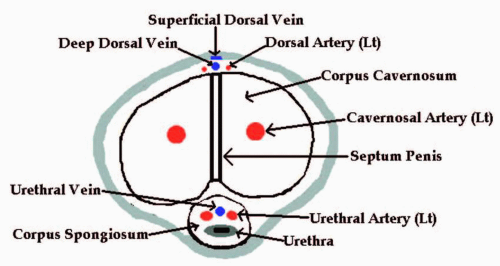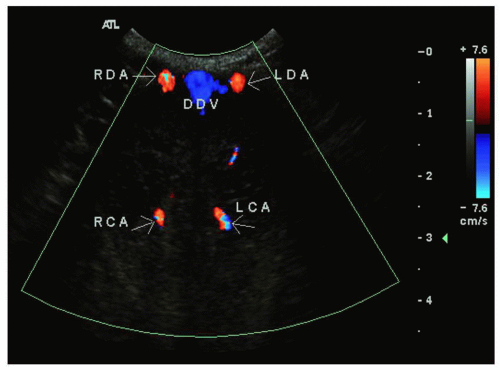Penile Vessels
I. ANATOMY
A.
The internal iliac arteries give rise to the internal pudendal arteries. Each internal pudendal artery gives off the urethral artery, the bulbar artery, and a perineal branch before it becomes the penile artery. Each penile artery divides into the right and left cavernosal arteries and the right and left dorsal arteries.
B.
The cavernosal arteries supply the corpora cavernosa and communicate directly with the sinusoidal spaces (small spaces that occupy the corpora cavernosa and the corpus spongiosum that fill with blood during an erection).
C.
The dorsal arteries supply the skin of the penis and glands.
D.
The urethral artery supplies the corpus spongiosum and urethral tissue.
E.
The bulbar artery supplies the urethral bulb and the bulbourethral gland.
F.
The emissary veins drain into the circumflex veins (both drain the corpus cavernosum) that then empty into the deep dorsal vein, which empties into the internal pudendal vein.
G.
The crural veins also drain the corpus cavernosum.
H.
The urethral veins drain the corpus spongiosum, and empty into the internal pudendal vein.
I.
The superficial dorsal vein drains the skin and subcutaneous tissue.
II. PATHOLOGY
A. Erectile Dysfunction
1. An erection is produced when the arterial beds relax, allowing blood to fill the sinusoids and causing an increase in blood flow and pressure, which causes mechanical pressure on the veins that prevents or decreases venous drainage from the penis.
2. Failure to achieve an erection can be due to:
a. Arterial occlusive disease in the right and/or left cavernosal arteries, the penile artery, and the internal pudendal artery. This may be due to atherosclerosis or trauma. Cigarette smoking, high cholesterol, and hypertension are associated with atherosclerosis.
b. Veins that drain the penis may not become sufficiently compressed during an erection and thus arterial blood escapes. This may be due to degenerative changes (from old age, diabetes, or Peyronie disease) or trauma resulting in penile fracture. Peyronie disease is a condition in which a focal “plaque” or scar develops on the tunica albuginea (the thick fascial outer layer that surrounds the corpora cavernosa and the corpus spongiosum) of the corpora cavernosa. During an erection, this causes the penis to have a curvature or bend in that area.
c. Insufficient smooth muscle relaxation, which does not allow enough blood to fill the sinusoids and compress the veins.
d. An arteriovenous malformation allows blood to leave the corpus cavernosum before a sufficient blood pressure is achieved.
e. Other nonvascular causes of erectile dysfunction may include any disease or problem affecting the brain, spinal cord, cavernous nerves, pudendal nerves, or receptors in the cavernous smooth muscles and terminal arterioles; endocrine disorders such as hyperthyroidism, hypopituitarism, and several types of pituitary tumors; as well as drugs (such as nicotine with cigarette smoking) that interfere with local neurovascular or central neuroendocrine control of the smooth muscle of the penis.
B. Varicoceles
1. This is another vascular problem in which the veins of the pampiniform plexus or cremasteric plexus become greatly enlarged.
2. This occurs more often on the left side due to the higher pressures from the left hemiscrotum draining into the left renal vein. The presence of a varicocele on the right may indicate a mass pressing somewhere on the venous pathway.
3. The presence of a varicocele increases the temperature in the scrotum and lowers the sperm count.
4. It may produce pain and swelling and may be palpated.
5. The varicocele may be removed by ligating thelarge draining vein, thus allowing the dilated venous tissue to die and become absorbed by the body.
III. HISTORY: QUESTIONS TO ASK THE PATIENT
A.
Have you had any difficulty with achieving an erection?
B.
Have you noticed any curvature to your penis?
C.
Are you having fertility problems?
D.
Are you having any pain or swelling?
E.
Have you noticed any lumps, or feel a structure that feels like a “bag of worms” in your scrotum?
F.
Do you smoke?





